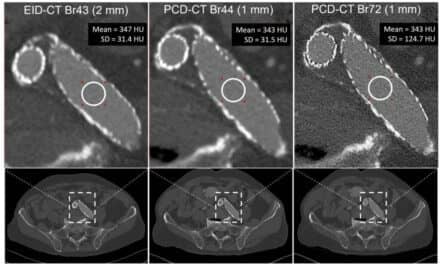Research in nuclear imaging techniques has never strayed far from incorporating new knowledge of fundamental physiological mechanisms into the design and formulation of new imaging agents. This is probably best represented in the decades-old interest in antibody, and the more recent concentration in peptide imaging. New knowledge notwithstanding, it remains technically challenging to label physiologically active natural products and synthetic organic materials with radionuclides while maintaining their biological potency. Techniques in combinatorial chemistry now permit investigators to synthesize and label myriad variations of molecules of interest. Testing the effectiveness of such agents in animal models is another time-consuming task. Despite such obstacles, there appears to be a major drive in developing radiolabeled, small peptides for a host of indications. Two such imaging agents, Tc-99m depreotide and Tc-99m apcitide, received FDA approval and have been commercially available for more than a year. The growing experience with these agents now permits an assessment of their performance from both technical and economic perspectives. Such an assessment will be useful in understanding how peptide imaging will fare in the current health care marketplace. It will also be useful in describing whether agents in current development will receive attention and adoption as they are positioned in that marketplace.
Tc-99m depreotide for Lung Cancer Imaging
Market clearance for Tc-99m depreotide was announced on August 4, 1999. It was introduced as a novel peptide-based imaging agent intended to help physicians distinguish between benign and malignant pulmonary lesions.[1-4] A segment of an estimated 170,000 new cases of lung cancer in the United States each year could potentially benefit from such an agent. The class of custom-designed peptides represented by this agent was created with the assistance of technology patented by the National Institute of Dental and Craniofacial Research (NIDCR). Frank Robey, MD, a senior investigator in NIDCR’s Division of Intramural Research, developed a chemical procedure that facilitates the creation of complex, custom-designed peptides and peptide-based reagents. In 1991, Robey and his colleagues patented a method by which synthetic peptides could be linked together in a precise manner or joined to other molecules at defined locations along the peptide chain. The investigators accomplished this by developing a chemical procedure that incorporated “chloroacetyl” or “bromoacetyl” groups at strategic positions in a synthetic peptide chain. Properly placed, these highly reactive groups permit peptides to be linked in a “head-to-tail” arrangement, resulting in the formation of cyclic peptides or peptide polymers. The reactive groups also provide sites for attaching various other atoms and chemical groups, such as radionuclides. This powerful technology allowed peptides to be manipulated in ways that formed the basis of Tc-99m depreotide’s synthesis and production. Fundamentally, Tc-99m depreotide is modeled on somatostatin, a naturally produced cyclic peptide. Somatostatin binds intensely to malignant lung tumors, which overexpress the somatostatin receptor, but does not bind to benign tumors. Tc-99m depreotide, a synthetic somatostatin, was linked to 99m Tc isotope using Robey’s method.
The potential clinical utility of noninvasively detecting somatostatin receptor-bearing pulmonary lesions in patients presenting with lesions on CT or chest radiography who have known malignancy or who are highly suspect for malignancy is obviation of needle biopsy, a technique with an adverse event rate of up to 10%. Although Tc-99m depreotide is not considered an alternative to CT or biopsy, it potentially increases the overall diagnostic accuracy associated with evaluation of suspected lung cancer. In addition to differentiating benign from malignant pulmonary nodules, obtaining more timely information, evaluating treatment response, and detecting recurrence of lung malignancies, this imaging agent offers potential cost savings by obviating repeat imaging studies and invasive procedures.
Clinical Performance
In two multicenter, open-label studies involving 270 patients using Tc-99m depreotide image information exclusively, sensitivity of approximately 71% and specificity of 86% were reported.5,6 These values were obtained from blinded readers who were uninformed regarding patient history or findings from other imaging studies. In Phase III pivotal studies, Tc-99m depreotide and CT scans were interpreted blindly by three nuclear medicine physicians and three diagnostic radiologists, respectively. The majority score for the presence or absence of malignancy was used in the statistical analysis. The location and score of Tc-99m depreotide and CT scan results were compared with the biopsy results of the presenting lesion identified at study enrollment. The results are summarized in Table 1.
The prevalence of malignancy in the evaluated 226 patients was extremely high (75% in study A; 88% in study B). This suggests that the overall negative predictive value is artificially low. In these 226 patients, the lesions that were biopsy positive for malignancy had histopathology results consistent with squamous cell (34%), adenocarcinoma (32%), other non-small cell (21%), small cell (6%), and other malignant cell types (7%). The interpretation of Tc-99m depreotide images was negative in 29% (54/184) of patients when the biopsy reports were positive for adenocarcinoma, squamous cell, carcinoid, or non-small cell cancer (ie, false-negative Tc-99m depreotide scans); lesion size ranged from 1 to 7 cm on CT. Additionally, the interpretation of Tc-99m depreotide was false-positive in 17% (7/42) of patients when the biopsy results were consistent with acute or chronic inflammation, infectious processes including abscess and pneumonia, hamartoma, fibrosis, or caseating or noncaseating granulomas. [5, 6]
For two studies of patients who were suspect for malignancy, two different retrospective analyses were performed to explore the potential diagnostic use of combined Tc-99m depreotide and CT blinded-image interpretations. One retrospective analysis of a subset of 127 patients with a solitary pulmonary nodule implies that the combined interpretation improved specificity. In another retrospective analysis of all 226 patients who had a CT scan, finding a positive CT and a positive Tc-99m depreotide image suggests an improved positive predictive value. There were 202 patients who had positive CT scans. In this setting, CT alone had a positive predictive value of 85%. In a retrospective analysis of this subset of 202 patients, when both the CT scan and the Tc-99m depreotide scans were interpreted as positive, the positive predictive value increased to 97%.
Economic Considerations
To determine the cost-effectiveness of Tc-99m depreotide, a cost analysis was performed. The cost basis for the comparator technologies is shown in Table 2, and it is based on available charge data; these charges are based on the 1999 Medicare fee schedule. The total charge for Tc-99m depreotide imaging was set at $500.
The results of the cost analysis are indicated in Table 3, which presents the cost per quality-adjusted life year (QALY) in a person with suspected lung carcinoma. The cost of diagnosing every patient with suspected disease (solitary pulmonary nodule) is indicated as $/QALY, a common output from cost-effectiveness studies.
The charge/QALY is an adjustment based on the Medicare allowable charge for the study, clinical diagnostic accuracy of the technique, adverse event rates associated with the technique, and other factors. It is not surprising that Tc-99m depreotide demonstrates relative cost-effectiveness in comparison to needle biopsy and mediastinoscopy, invasive techniques that may not be suitable for all patients and methods that represent potential risk. Fluorine 18-labeled deoxyglucose (FDG-PET) imaging is very expensive in this setting largely because of the high cost basis of the study itself.
Further Consequences
Peptide imaging with Tc-99m depreotide is a present-day reality. The legacy of antibody imaging in nuclear medicine continues through the formulation and commercialization of peptides. It is encouraging that a peptide demonstrates significant cost-effectiveness after being on the market for only 1 year. This is an indication of the need for noninvasive imaging tools to replace relatively expensive invasive techniques; it is also an indication that a peptide imaging method can offer meaningful utility in the diagnosis of malignancy. As other imaging peptides are developed and marketed, it will be important to track their market positioning. If these products are positioned correctly, they will be successful very soon after their introduction. If not, they will flounder in a busy marketplace while their utility and adoption are defined and corrected by market forces.
The consequences of positioning peptide imaging correctly cannot be overstated from an economic perspective. The relative cost of an imaging technique should not only be linked to its average wholesale price when considering marketing initiatives. It must be maintained that the cost of a technique bears on the marketplace and health spending in general. It must also be maintained that cost-effectiveness will have to be demonstrated in comparison to known reference techniques for which a significant body of clinical evidence already exists. Further advances in peptide imaging will strengthen this emerging field if the commercial results of these products are associated with the management of disease at a population level. To expect that the cost of peptide imaging will be borne by out-of-pocket expenditures represents a short-sighted view of the present state of health economics. To expect that new imaging peptides will offer improved accuracy, obviation of invasive procedures, and favorable cost-effectiveness in comparison to old standards represents the opportunity to grow this imaging approach in a timely manner.
Frank J. Papatheofanis, MD, PhD, is director, Advanced Medical Technology Assessment and Policy Program, Department of Radiology, University of California, San Diego, and a member of the Decisions in Axis Imaging News editorial advisory board.




